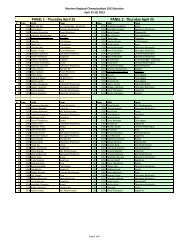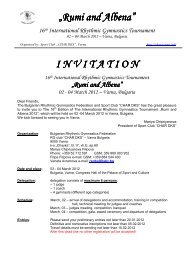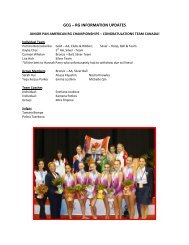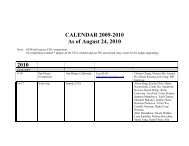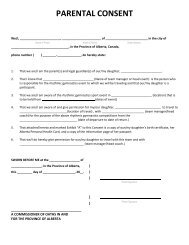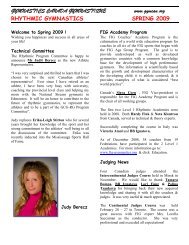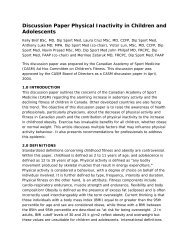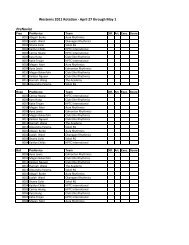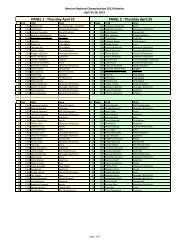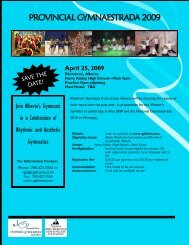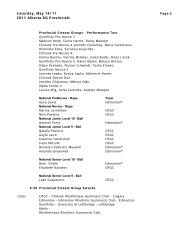Warming Up Cooling Down and Stretching - Rhythmic Gymnastics ...
Warming Up Cooling Down and Stretching - Rhythmic Gymnastics ...
Warming Up Cooling Down and Stretching - Rhythmic Gymnastics ...
Create successful ePaper yourself
Turn your PDF publications into a flip-book with our unique Google optimized e-Paper software.
Warm-up exercises are muscle-group-specific. It would be of little or no benefit to a<br />
runner to perform a series of h<strong>and</strong> <strong>and</strong> wrist exercises before a race. That may be<br />
an extreme example, but the principle holds true: Warm up with the same exercise<br />
that will be used in the workout, but at a slower pace. Three or four minutes should<br />
suffice.<br />
How about stretching as a warm-up <strong>Stretching</strong> has a purpose - after the workout<br />
<strong>and</strong> after the cool-down. Studies have shown that stretching before exercise does<br />
not prevent either soreness or injury. Indeed, stretching cold muscles can cause<br />
muscle fiber tears. There is no objection to first warming up, <strong>and</strong> then performing<br />
specific stretches for those muscles that will be employed in the workout.<br />
Better yet, exercisers can perform a range-of-motion routine for the limbs <strong>and</strong><br />
torso. Be careful they don't force the range to the point of pain or significant<br />
discomfort.<br />
Preventing injury is largely a matter of proper biomechanics, effective training for<br />
the workout <strong>and</strong> not pushing past training thresholds<br />
<strong>Cooling</strong> down<br />
<strong>Cooling</strong> down (or warming down) is important after a workout. There are two<br />
reasons for a warm down. The first is more important, <strong>and</strong> concerns systemic<br />
circulation. When an exerciser has been moving at a strong pace for a time, heart<br />
rate <strong>and</strong> blood volume are elevated. Cardiac output during exercise is driven by 1)<br />
a high volume of blood return; 2) greater dilation of the chambers of the heart; <strong>and</strong><br />
3) stronger contraction of the myocardial muscle particularly of tale left ventricle.<br />
The pulsation of the arteries completes the systolic blood pressure phase of the<br />
cardiac cycle throughout the arterial side of the circulatory system. The return of<br />
blood to the heart through the venous side of the system has no such primary<br />
pump. Return blood flow depends on venous pressure at 10 to 15 mmHg, a minimal<br />
force compared to arterial pressure of 8 to 120 mmHg.<br />
During exercise, particularly lower-body exercise, the rhythmically contracting<br />
muscles act as pumps to speed up the venous blood flow hack to the heart. In<br />
weight-bearing exercises such as running, exercise walking <strong>and</strong> cross country<br />
skiing, gravity is a significant force that must be overcome so that the heart<br />
receives enough blood to send to the lungs for re-oxygenation <strong>and</strong> on to all the<br />
vital organs <strong>and</strong> other tissues. If a runner stops moving after a race, the heart<br />
would continue beating rapidly for at least another minute or two. Blood in the<br />
lower body, however, would not have any help from the exercising muscles in its




